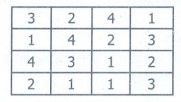English : Unit 6 : Prose : From Zero to Infinity – Biography of Srinivasa Ramanujan
Warm up
Solve this
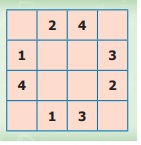
* Did you enjoy solving this? Answer: Yes/No
* Was it easy or hard to solve? Answer: its hard / its easy
* Do you like Mathematics? Give reasons. Answer: Yes I like. Solving answer to questions are very interesting.

* What was the reaction of the classmates to Ramanujan’s question?
The classmates laughed at Ramanujan’s questions
* What did the Indian mathematician Bhaskara prove?
The Indian mathematician Bhaskara proved that zero divided by zero is infinity.
* Where did Ramanujan get S.L. Loney’s book on Trigonometry?
Ramanujan got “Loney’s Trignometry” book from a college library.
* Where did Ramanujan do his mathematical problems?
Ramanujan used to do problems on loose sheets of paper or on a slate.
* What were the subjects neglected by Ramanujan in college?
The subjects neglected by Ramanujan in college were History, English and Physiology.
* Which University granted him a fellowship of ₹75 a month?
The university of Madras granted him a fellowship ₹75 of a month.
* What did Ramanujan send to G.H. Hardy?
Ramanujan sent a letter to G.H. Hardy in which he set out 120 theorems and formulae.
* Who discovered a rare mathematical genius in Ramanujan?
G. H. Hardy and his colleague, J.E. Littlewood discovered a rare mathematical genius in Ramanujan.
Glossary
absurd (adj.) – stupid and unreasonable, silly in a humorous way
infinity (n) – unlimited space, time, amount, a number large beyond any limit
intriguing (adj.) – very interesting because of being unusual or mysterious
prodigy (n) – a child who shows a great ability at a young age
dingy (adj.) – a dark and dirty place
Physiology (n) – the branch of biology that deal with the normal functions of living organisms and their parts
unkempt (adj.) – not neat or cared for
uncouth (adj.) – behaving in an unpleasant way
conjecture (n) – an opinion or conclusion formed on the basis of incomplete information.
discrepancy (n) – an illogical or surprising lack of compatibility or similarity between two or more facts
distinguished (adj.) – used to describe a person, respected and admired for excellence
devouring (adj.) – destructively consuming
disembark (v) – to leave a ship, aircraft, etc. after a journey
emaciated (adj.) – very thin and weak, usually because of illness or extreme hunger
agonising (adj.) – causing extreme physical or mental pain
A. Answer the following questions in a sentence or two.
1. Why did the students laugh at Ramanujan?
Ramanujan asked a silly question, “If no banana is distributed among no one, will everyone still get one banana” in the class. So the children laughed at him.
2. Why did the teacher compliment Ramanujan?
The teacher complimented Ramanujan for asking a question that took centuries for mathematicians to answer.
3. What did Ramanujan do after reading the book on Trigonometry?
Ramanujan mastered the book and also began his own research.
4. What disappointed Ramanujan’s father?
Ramanujan failed twice in his first year arts examination in college because he neglected History, English, Physiology. This disappointed his father.
5. How did Ramanujan manage his paper crisis?
Ramanjan started using even scraps of paper he found lying on the streets. Thus he managed his paper crisis.
6. Why were Ramanujan’s application for jobs rejected?
No one could understand what was written in the note books. Ramanujan showed to prove his mathematical skills. So, his applications for jobs were rejected.
7. Why was Ramanujan sent back to India?
Ramanujan was sent back to India because he was suffering from an incurable Tuberculosis.
B. Answer the following questions in about 80 – 100 words.
1. Describe the life of Srinivasa Ramanujan in India.
Lesson : : From zero to Infinity
Author : Anonymous (Biography of Ramanujan)
Characters : Ramanujan, Classmates, Teachers and Ramanujan’s Father
Theme : Inborn intelligence with diligence leads to excellence.
Srinivasa Ramanujan was born on December 22, 1887. He was born in Erode, Tamil Nadu. His father was a petty clerk. He was a prodigy from childhood. He was ahead of his teachers. He also taught his senior students. When he was 13, he got Loney’s Trigonometry from library. He made his own research. He secured first class in Mathematics. He was given Subramanyan scholarship. But he failed twice in Arts. His father was upset. Ramanujan needed money for food and papers. He started using paper scraps. His notebooks impressed the Director of Madras Port Trust, Francis Spring. He gave him job. His salary was ₹22 / month. Later he got research fellowship. He had no degree. But the Madras University gave him fellowship of ₹75.
“There is no great genius without some touch of madness.
2. Narrate the association of Ramanujan with G.H. Hardy.
Lesson : From zero to Infinity
Author : Anonymous (Biography of Ramanujan)
Characters : Ramanujan and G.H. Hardy.
Theme : “Fellowship happens when mercy wins over justice”
Ramanujan sent a letter to G.H. Hardy with 120 theorems and formulae. Soon Hardy and Littlewood discovered a mathematical genius. They arranged for Ramanujan’s travel for Cambridge University. He found it hard to stay. He was a elected fellow of the Royal Society on February 28, 1918. He was the youngest Indian to receive this. In October, he was the first Indian to be elected to Trinity College, Cambridge. His achievements were Hardy Ramanujan Littlewood circle method. Due to Tuberculosis, he came to India. To forget the pain he again played with numbers till he died.
“A good communication is the best medicine for healthy association”.
COMMON PARAGRAPH
PARAGRAPH FOR TOPPERS:
Synopsis:
• Introduction
• Early childhood and education
• Turning point in his life
• Frayed note books
• Genius in Maths
• Ramanujan and Hardy
• Sickness
• Conclusion
Introduction:
This lesson “From Zero to Infinity” is a biography of Ramanujan. He was an Indian mathematician. He lived during the British rule in India. He is one such prodigy. His knowledge of mathematics was extraordinary.
Early childhood and education:
Ramanujan was born in Erode on December 22, 1887. His father was a clerk in a cloth shop. At the age of 13, he was able to get Loney’s Trigonometry book. He mastered this difficult book. He began his own research. He came forth with many mathematical theorems and formulae.
Turning point in his life:
Ramanujan used to do problems on loose sheets of paper or on a slate. He jot the results down in notebooks. One of his senior students showed him synopsis of elementary results in pure applied mathematics book by G.S. Carr. He began work on the problems given in it. This book triggered the mathematical genius in him.
Frayed note books:
Mathematical ideas came to his mind like a flood. He was not able to write down all of them. He noted down in three note books. They are known as Ramanujan’s Frayed note books.
Genius in Maths:
Ramanujan got a first class in Maths. But he failed in arts subjects. His father found him scribbling numbers. He thought he had gone mad. He had no money. He needed money to buy papers to write. He would visit offices. No one gave him a job. The director of Madras Port Trust gave him a critical job.
Ramanujan and Hardy:
Ramanujan had sent a letter to the mathematician G.H. Hardy of Cambridge university. In that letter he set out 120 theorems and formulae. Hardy called Ramanujan to Cambridge University. Ramanujan found himself a stranger. He had to cook his own food. Inspite of the hardship he continued his research. He was elected fellow of Royal society. He was the youngest Indian to receive it.
Sickness:
While Ramanujan continued his research, he suffered from Tuberculosis. It is an incurable disease. His health became too worse. He became very thin and weak. So, he was sent back to India.
Conclusion:
Ramanujan had unbearable pain. But he did not stop his research. His life and achievement proves to be an inspiration for the young Indians.
PARAGRAPH FOR AVERAGE STUDENTS:
Title : From zero to Infinity
Author : Anonymous (Biography of Ramanujan).
Theme : Inborn intelligence with diligence leads to excellence.
Ramanujan was born in Erode on December 22, 1887. At the age of 13, he was able to get Loney’s Trigonometry book. He mastered this difficult book. He used to do problems on loose sheets of paper or on a slate. He jot the results down in note books. Mathematical ideas came to his mind like a flood. He was not able to write down all of them. He noted down in three note books. The director of Madras Port Trust gave him a clerical job. Ramanujan had sent a letter to the G.H. Hardy of Cambridge University. In that letter he set out 120 theorems and formulae. Hardy called Ramanujan to Cambridge University. Ramanujan found himself a stranger. Inspite of the hardship he continued his research. He suffered from Tuberculosis. But Ramanujan continued his research. His health became too worse. Later he was sent back to India. His life proves to be an inspiration for the young Indians.
PARAGRAPH FOR LATE BLOOMERS:
• Ramanujan was born in Erode.
• He was genius in Maths.
• At the age of 13, he got Loney’s Trigonometry book.
• He mastered this difficult book.
• He jot the result down in note books.
• The director of Madras Port Trust gave him a job.
• He sent a letter to G.H. Hardy.
• Hardy called him to the Cambridge.
• Life at Cambridge was not easy.
• He suffered from Tuberculosis.
• Later he was sent back to India.
C. Match the words with correct Synonym and Antonym from the table.
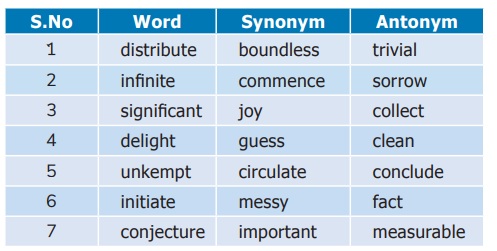
Answer:
Word : Synonym × Antonym
1. distribute : circulate × collect
2. infinite : boundless × measurable
3. significant : important × trivial
4. delight : joy × sorrow
5. unkempt : messy × clean
6. initiate : commence × conclude
7. conjecture : guess × fact
LISTENING
D. Listen to the anecdote “Two Geniuses” and narrate it in your own words.
Listen to the Passage Two Geniuses
Many people regard the scientist Albert Einstein as one of twentieth century’s greatest geniuses. He was a physicist whose research into the working of the universe made such inventions as nuclear energy, space travel and television possible.
Anecdotes about Einstein show that he had a great sense of humour. One such anecdote tells that as a young man with a growing reputation, he received many invitations to go to universities to explain his theories. On these trips he was always chauffeured by the same person—a man called Hans. Hans often said to him, “It’s a pleasure to drive a genius like you, Dr. Einstein.”
One evening, on their way to a remote university, Einstein said, “I wish I didn’t have to give my lecture tonight, Hans. I’m so tired. But I can’t let my audience down, can I.”

“You don’t need to,” said Hans. “We’ll change places, and I’ll give the lecture for you. I’ve listened to it a dozen times. I don’t understand it, but I know it by heart. And no one knows you at the university, do they? No one will find out.”
Einstein eventually agreed with Hans, but said to him, “Don’t try to answer any questions, whatever you do.”
They changed places, and at the university, Hans was greeted and led to the platform in a great hall crowded with professors and students. Einstein joined the audience and listened to Hans give his lecture perfectly, and joined in the applause at the end.
However, before Hans could get off the platform, a professor shouted from the audi-ence, “I’d like to ask you a question. Its very difficult but please answer it.” He then asked the question so difficult that Hans had no idea what he was talking about.
Einstein thought, “Oh Dear, now we’re in trouble.” But Hans just laughed and said, “That’s not a difficult question, sir. In fact, it’s so easy even my driver knows how to answer it. Hans, stand up and……..”
Einstein stood up and answered the question perfectly.
They left the university, with Einstein driving. A little later, Hans offered to take over from him. “No, my friend,” laughed Einstein, “it’s a pleasure to drive a genius like you.”
‘Two Geniuses”
The story tells about Einstein’s great sense of humour.
There was a young man, Einstein, with a growing reputation. He was invited by universities to explain his theories. A man called Hans was always his driver. Hans often told Einstein that it was a pleasure to drive for a genius.
One evening, on their way to a remote university, Einstein told Hans that he was not able to give his lecture that night. He said that he was very tired. But he did not want to let his audience down.
Hans said that they would change places and we would give the lecture for him. He didn’t understand it but knew it by heart. More over no one knew him at the university. Hans was sure that no one would find it.
Einstein agreed with Hans. But Einstein told Hans not to try to answer any questions.
They changed places, and at the university, Hans was greeted and led to the platform in a great hail crowded with professors and students. Einstein joined the audience and listened to Hans give his lecture perfectly and joined in the applause at the end.
Hans was about to get off the platform. Before that, a professor shouted from the audience. He wanted to ask a question. He said that it was very difficult but he requested him to answer it. Then he asked the very hard question for which Hans had no answer.
Einstein thought that they were in trouble. But Hans just laughed and said that, wasn’t a difficult question. Hans said that it was so easy and even his driver knew how to answer it. Hans asked Einstein to stand up.
Einstein stood up and answered the question perfectly.
They left the university, with Einstein driving the car. A iittle later, Hans offered to take over him. Einstein laughed and told no to his friend. He said that it was his pleasure to drive a genius like him (Hans).
SPEAKING
E. Divide the students into groups of five and conduct a group discussion on the topic “Importance of Mathematics in Our Everyday Life”. The teacher will act as a moderator.
Topic : Importance of mathematics in our Everyday life.
Moderator: Today we have assembled here in five groups to discuss on the topic “Importance of Mathematics in our Everyday life. We shall begin with group A.
Group A: Mathematics is a methodical application of matter. It makes a man systematic. Mathematics makes our life orderly and prevents chaos. Certain qualities that are nurtured by mathematics are power of reasoning, creativity, abstract thinking, problem solving ability and effective communication skills.
Group B : Mathematics is the cradle of all creations, without which the world cannot move an inch. Even insects use mathematics in their everyday life for existence. There are countless examples of mathematical patterns in natures fabric. A good curriculum of mathematics is helpful in effective teaching and learning of the subject.
Group C: Experience says learning mathematics can be made easier and enjoyable if our curriculum includes mathematical activities and games. Mathematics puzzles and riddles encourage and attract an alert and open minded attitude among youngsters and help them develop clarity in their thinking. Emphasis must be laid in development of clear concept in mathematics in a child, right from the primary classes itself. The child must be appreciated for every correct attempt. And the mistakes must be corrected then and there without any criticism.
Group D: The greatest hurdle in the process of learning mathematics is lack of practice. Students must work out some problems from different areas to master the basic concept and develop speed and accuracy in solving a problem. Another very effective means of spreading the knowledge of mathematics among children is through peer teaching. In the process their doubts on the topic and clear them through discussions in a group.
Group E: The present age is one of skill development and innovations. We are more mathematical in our approach the more successful we will be. Mathematics offers rationality to our thoughts. It is a tool in our hands to make our life easier. We must appreciate the beauty of the subject and embrace it with all our heart.
Moderator : From the discussions it is clear that maths has become inseparable part of our lives and whether work in an office or spend most of our time at home, each one of us uses mathematics as a part of our everyday life. No matter where we are as well as whatever we are doing mathematics is always there whether we notice it or not. Let us have a deep look at this universal subject how we use it in our everyday life.
READING
Automated Teller Machine (ATM) is an indispensable part of our lives now worldwide! John Shepherd-Barron once explained that he came up with the idea of cash dispensers in 1965 while lying in his bath after finding his bank closed. It was then his habit to withdraw money on a Saturday, but on this particular weekend he had arrived one minute late and found the bank doors locked against him.
Later that year, he bumped into the Chief General Manager of Barclays Bank who was about to have lunch. Shepherd-Barron asked him for 90 seconds to pitch his idea for a cash machine.
“I told him I had an idea that if you put your standard Barclays cheque through a slot in the side of the bank, it will deliver standard amounts of money around the clock.”
“He said, ‘Come and see me on Monday morning’.”
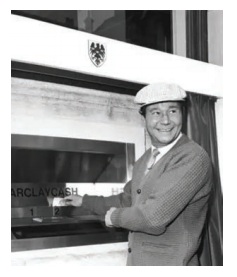
Barclays commissioned Shepherd-Barron to build six cash dispensers, the first of which was installed at a branch in the north London suburb of Enfield on June 27, 1967. The first person to withdraw cash was actor Reg Varney, a celebrity resident of Enfield known for his part in a number of popular television series. An early deployment of this device outside of the UK took place in Zurich in November, 1967.
Shepherd-Barron was born at Shillong, India in 1925 to British parents and later served in the Indian Army in Second Airborne division where he taught Gurkhas to parachute.He also invented the PIN by recalling his Indian Army number, he had originally intended to make Personal Identification Number (PIN) six digit long, but reduced the number to four when his wife, Caroline, complained that six was too many. “Over the kitchen table, she said she could only remember four figures, so because of her, four figures became the world standard,” he recalled.
All this was possible due to a mathematical prodigy by the name of Srinivasa Ramanujan — A mathematical genius of India. When you put your debit or credit card in the machine and order the machine to dispense the amount of your desire, the machine divides and arranges your money before dispensing it, using Ramanujan’s ‘Partition Theory’.
F. Answer the following questions based on the given passage.
1. What made John Shepherd-Barron to come up with the idea of ATM?
When Shepherd Barron had arrived one minute late, he found the bank doors locked against him. This incident made him come up with the idea of ATM.
2. When and where was the first ATM installed?
The first ATM was installed on June 27, 1967 in the North London suburb of Enfield.
3. Who was the first person to withdraw cash from the ATM?
Actor Reg Varney, a celebrity resident of Enfield was the first person to withdraw cash from the ATM.
4. Why did Shepherd-Barron reduce the PIN number from six digits to four?
Shepherd Barron reduced the PIN number from six digits to four when his wife, Caroline complained that six was too many.
5. Which theory of Ramanujan helps the ATMs to dispense cash?
Partition theory of Ramanujan helps the ATMs to dispense cash.
WRITING
Paragraph Writing
A paragraph discusses one idea in detail and aids the development of an overall topic for the essay. Paragraph length will vary depending on the purpose of the paragraph.
Parts of a Paragraph
The basic paragraph consists of three parts:
1. A Topic sentence,
2. Supporting details,
3. A Concluding sentence
Topic Sentence
The main idea of each paragraph is stated in a topic sentence. Generally, the topic sentence is the first sentence of a paragraph. All subsequent points made in the paragraphs should support the topic sentence.
Supporting Details
Supporting details elaborate upon and prove the topic sentence. Supporting details should be drawn from a variety of sources. The following are common sources of supporting details:
* Expert Opinion
* Brief Stories
* Facts and Statistics
* Research Studies
* Personal Experiences
* Interviews
Concluding Sentence
Each paragraph should end with a concluding sentence that ties together the ideas brought up in the paragraph and emphasizes the main idea one last time.
A model paragraph is given below:
An Unconventional Pianist
Glenn Gould is widely regarded as Canada’s most famous and eccentric pianist. He is renowned for his recordings of the music of Johann Sebastian Bach. For example, Bach’s Goldberg Variations, Gould’s first recording, was among the best-selling classical music albums of its time. Gould is also famous for his unusual behaviour. He would only play concerts while sitting on an old chair his father had made, and he usually hummed while he played. Contrary to most pianists, he disliked playing in concert halls, and devoted most of his career to the recording studio until his death in 1982. In brief, Glenn Gould was an unconventional pianist who made a significant impact on the world of music.
Topic Sentence Blue ; Supporting Detail #1Gray; Supporting Detail #2 Green; Concluding Sentence Violote;
G.
1. Write a paragraph of 100 – 120 words about a memorable anecdote/incident of your life.
“A memorable incident in my life”
It was my most exciting day in my life. When I remember that moment it makes me laugh easily. It was an incident when I was in class 8. It was November when our school had provided us with teacher trainees for various subjects and we all were playing rather than studying. The third period began and a teacher entered our class. We all decided to play a game called ‘Pen fighting game’. It was my turn to make a shot. When I was to make a shot, the trainee teacher came from behind. She asked me, ‘Where do you live?’ At that moment knocking the other pen down I told the teacher, ‘I live in my house’. My voice was so loud and there was laughter in the class. When the game was over, I realized that I misbehaved in the class. Then I decided to apologize. I went to her room and asked for her pardon. She smiled at me gently. That gave me a great relief in my heart. Now I am very attentive in my class.
2. Write a paragraph of 100 – 120 words about your favourite personality.
“My favourite personality”
Every one has his or her own favourite personality and so I do. My favourite personality is William Henry Bill Gates III. He is popularly called Bill Gates. He was born on October 28, 1955. He was a local resident of Seattle, Washington, United States. In his early ages, he began to show interest in computer programming. Gates excelled in Mathematics and Science. Because of his excellence, he enrolled in Lakeside, preparatory school. Most of his professions involved the computer software. He held the position of Technology advisor of Microsoft Corporation. He is the co-chair person of Bill and Melinda Gates foundation, an organisation which named after him and his sister. He is the CEO of Cascade Investment. He holds the highest position as the Chairman of Corbis. He and his partner, Paul Allen built the world’s largest software business. Due to his excellent software invention, Gates has received many big awards and achievements. He was the most powerful person in the world in 2012. He and his wife were awarded.
Grammar
Connectors
* We could go to the library or the park.
* He neither finished his homework nor studied for the test.
* I did not go out because the weather was hot.
In each of the above sentences, two different ideas are expressed in one sentence.To connect the ideas, some words like or, neither…nor, because are used. These words and phrases are called Connectors.
A connector may be used to indicate the relationship between the ideas expressed in a clause or a sentence.
The following connectors can be used for different purposes.
Look at the following sentences, how connectors are used.
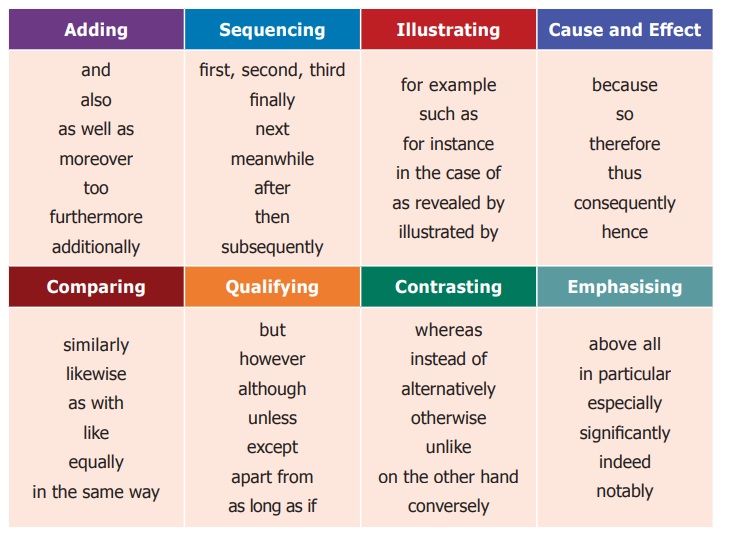
* The man has much money. However, he isn’t happy at all.
* I like playing football. On the other hand, my brother likes playing basketball.
* His family made a lot of effort to make their son’s lessons better, conversely, he never made any effort.
* She spent four years studying for her law degree. Meanwhile, she continued to work at the bank.
* You are not allowed to use your phone here. Similarly, you have to switch it off when you are in the library.
A. Complete the following sentences using appropriate Connectors from the box.
moreover, although, meanwhile, therefore, because, as long as, thus, above all, for instance, except
1. Irine felt cold although she was wearing a winter coat.
2. This restaurant has some of the best chefs in the town. moreover their service is excellent.
3. I’m not going to the party tonight because I didn’t get an invitation.
4. You can set the table. meanwhile, I’ll start making dinner.
5. I can play quite a few instruments. for instance, the flute, the guitar and the piano.
6. The store was out of chocolate chips; therefore they would need to make a different type of cookies.
7. The stores are open daily except Sundays.
8. I’ll stay as long as you need me.
9. This detergent is highly concentrated and thus you will need to dilute it.
10. It was the thing he prized above all.
Active Voice and Passive Voice
Read the following sentences and analyse the difference.
The team leader presented the report.
The report was presented by the team leader.
* In the first sentence, the verb shows that the subject is the doer of the action.
Therefore, the sentence is in active voice.
* In the second sentence, the verb shows that the subject is not the doer of the action. Therefore, the sentence is in passive voice.
We use the Passive voice when –
*the focus is on the action rather than the doer of the action.
(e.g.)About 50 per cent of the graduates are employed in IT related sectors.
*we do not know who the doer is.
(e.g.)My bike was stolen yesterday.
*we talk of a system or a process.
(e.g.)The vegetables are washed well. Then, they are cut into cubes.
* we write newspaper headlines and notices at public places. (‘be’ verb is omitted as the language has to be concise)
(e.g.) 20 sportsmen felicitated by PM.
*we describe changes that have taken place.
(e.g.) Our school looks completely different. The whole place has been painted.
Look at the below table. It shows the changes in tense while changing sentences from active voice into passive voice.
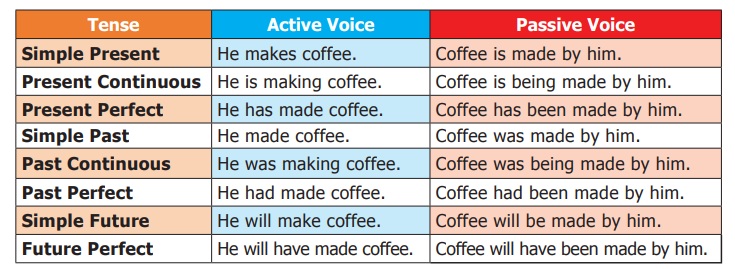
B. Convert the following active sentences into passive sentences by supplying an appropriate passive verb form.
1. She will not recognize us. / We ____________ by her.
a. will not recognize
b. will not being recognized
c. will not be recognized
2. They didn’t invite me, but I went anyway. / I ________________ but I went anyway.
a. wasn’t invited
b. wasn’t being invited
c. wasn’t inviting
3. They broke up the table for firewood. / The table ____________ up for firewood.
a. broke
b. had broken
c. was broken
4. She has won the first prize. / The first prize ______________ by her.
a. has won
b. has been won
c. had been won
5. A friend of mine is repairing the car. / The car _______________ by a friend of mine.
a. is repairing
b. is repaired
c. is being repaired
6. Begin the work tomorrow. / Let the work ____________ tomorrow.
a. be begun
b. begin
c.is beginning
7. They speak English in New Zealand. / English _______________ in New Zealand.
a. is speaking
b. is spoken
c. is being spoken
8. His attitude shocked me. / I _______________ by his attitude.
a. had shocked
b. had been shocked
c. was shocked
9. She had already sent the parcel. / The parcel _______________ by her.
a. has already been sent
b. had already been sent
c. was already sent
10. Her silence worries me. / I _______________ her silence.
a. am worrying by
b. am worried by
c. have worried by
C. Match the following Active voice sentences with Passive voice
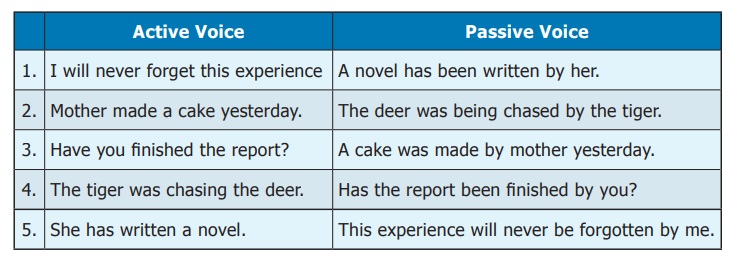
Answer:
Active Voice : Passive Voice
1. I will never forget this experience : This experience will never be forgotten by me.
2. Mother made a cake yesterday. : A cake was made by mother yesterday.
3. Have you finished the report? : Has the report been finished by you?
4. The tiger was chasing the deer. : The deer was being chased by the tiger.
5. She has written a novel. : A novel has been written by her.
Imperatives in Passive
Let + object + be + past participle. (Positive)
(e.g) Open the window. (Active)
Let the window be opened. (Passive)

Let + object + not + be + past participle. (Negative)
(e.g) Do not pluck the flowers. (Active)
Let the flowers not be plucked. (Passive)
Look at these imperatives in passive and compare.
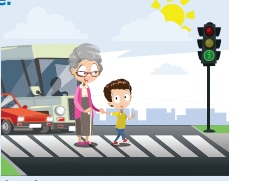
Active: Help me.
Passive: You are requested to help me.
Active: Don’t touch it.
Passive: You are warned not to touch it.
(Note: We can begin the passive sentence with you if we want to put emphasis on the person addressed to.)
D. Change the following into passive voice.
1. Stanley will inform you later. Answer: You will be informed by Stanley later.
2. People speak Portuguese in Brazil. Answer: Portuguese is spoken by people in Brazil.
3. My grandfather built this house in 1943. Answer: This house was built in 1943 by my grand father.
4. Do not hurt the animals. Answer: Let the animals not be hurt / Let not the animals be hurt
5. You must not drop litter in the streets. Answer: Litter must not be dropped in the streets by you.
6. Carry it home. Answer: Let it be carried home.
7. They are decorating the wall. Answer: The wall is being decorated by them.
8. He has already mended the TV set. Answer: The TV set has already been mended by him.
Project
E. Make a scrapbook of ‘Famous Biographies’ by collecting at least five biographies of famous scientists, mathematicians, inventors, artists etc., of your choice. You may also collect the pictures related to their achievements, inventions etc.

“Famous Biographies”
1. Sir Isaac Newton (1642 – 1726).
Sir Isaac Newton was a polymath who made investigations into a whole range of subjects including mathematics, optics, physics and astronomy. In his Principia Mathematica published in 1687, he laid the foundation for classical mechanics explaining the law of gravity and the laws of motion. In mathematics, he also studied power series, binomial theorem and developed a method for approximating the roots of a function.
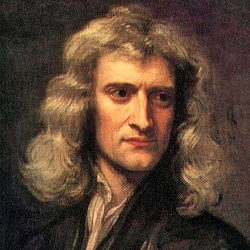
2. Pythagoras (c. 570 BC – c 495 BC)
Pythagoras was a Greek Philosopher, spiritual leader and a mathematician. Pythagoras was believed to be one of the western men to describe himself as a philosopher ‘lover of wisdom’. His philosophy was based on the mystic traditions of Egypt and Greece. He is also credited with ‘Pythagoras theorem’ about the relation of triangles in geometry.

3. Thomas Alva Edison (1847 -1931)
Thomas Edison was an American inventor who filed over 1000 patents. He developed and innovated a wide range of products from the electric bulb to the phonograph and motion picture camera. He was one of the greatest inventors of all time.
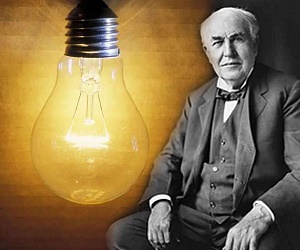
4. Auguste Renoir
Auguste Renoir was a French Painter, one of the early pioneers of impressionism. Also influenced by Italian renaissance. Famous works include dance at the Mouline de la Galette and on the Terrace.
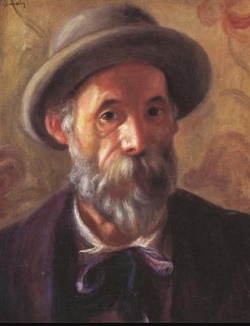
Collect pictures of famous personalities in Science, Mathematics, Literature art etc.
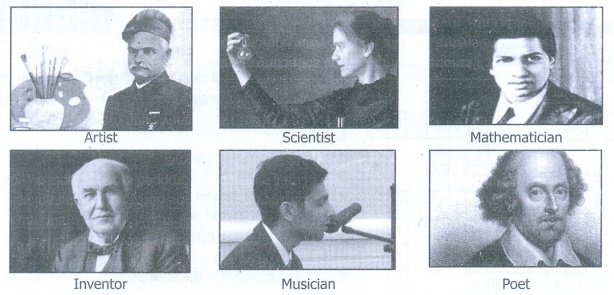
Solution to warm up riddle:
